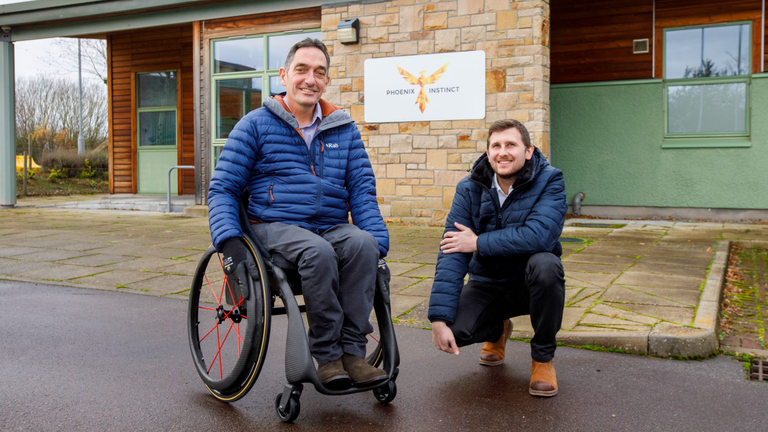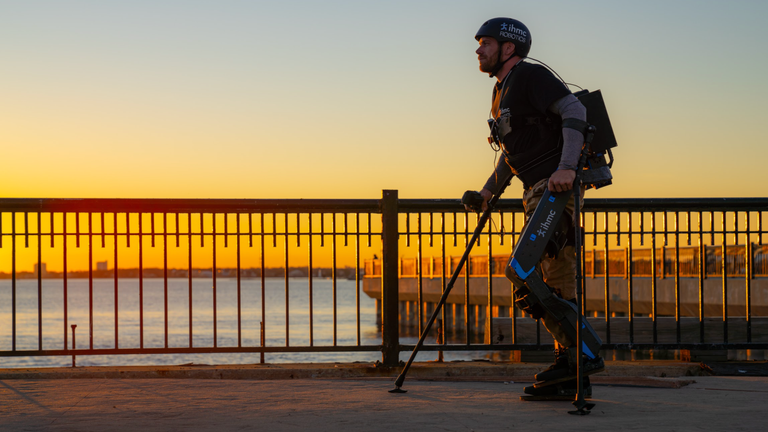A British inventor and entrepreneur has won a $1m (£740,000) prize to help him continue to develop a revolutionary ultra-light, stable carbon fibre wheelchair.
The Mobility Unlimited Challenge was launched three years ago alongside a $4m (£3m) pledge to a range of teams around the world to help change the lives of people with lower-limb paralysis.
As a wheelchair user himself, the Scottish winner of the challenge, Andrew Slorance, 51, was acutely aware of how tipping over backwards was the primary cause of accidents for wheelchair users – and the Phoenix i wheelchair aims to end this.
Tipping over happens “because the wheelchair has a fixed centre-of-gravity, but the user doesn’t,” Mr Slorance explained.
“If the user moves too far out of sync with the fixed position of the wheelchair, they’re going to fall over.”
One way to deal with this is by having the axle to the back of the wheelchair and putting the user’s weight to the front of it – but this brings new challenges.
When the weight is carried by the small front wheels, this adds drag, making pushing and turning much more difficult, and introducing uncomfortable vibrations that can cause pain and muscle spasms.
Wheelchair designs have previously had to make a trade-off between agility and stability, but Mr Slorance’s new design allows the wheelchair to automatically change the weight distribution itself, keeping users balanced while also ensuring they’re as agile as possible.
“The wheelchair as we know it has been technologically unchanged for decades,” said Mr Slorance.
He explained how he had broken his back when he was 14 after falling from a tree.
“I remember lying in the hospital bed in Aberdeen and an occupational therapist came in and she wheeled a wheelchair up to my bed,” Mr Slorance said.
“She said, ‘Andrew, I’ve got your new wheelchair for you. I hope you will agree it’s rather a nice example’.
“I looked at this thing and I thought: ‘You’ve got to be kidding right?’ The first day I went out in that wheelchair was without doubt the worst day of my life.
“I felt completely immobilised because the thing was so big… I suddenly realised everybody was looking at me in a way people had never looked at me before.”
Mr Slorance – who designed the device with his company Phoenix Instinct – said the prize money would help advance the development work and get the new design to the consumer.
“Your wheelchair is the world’s first perception of you. If that thing looks awesome and hi-tech, that puts forward a positive perception,” he said.
“We live in a time when our fridge freezer can be smart, it can tell us the milk we put in has gone out of date.
“Yet the wheelchair is the thing you actually need every day of your life… and it’s still got the technology from 1984. This is a game changer.”
The other finalists, who have all received a share of the total prize money, include a powered exoskeleton called Quix, designed by researchers from IHMC & MYOLYN the US.
Another American team reached the finals for their Evowalk simulator, a wearable that goes below the knee and uses AI to support users’ muscles and help people going through rehabilitation for walking.
A third finalist called Qolo (Quality of Life with Locomotion) came from the University of Tsukuba in Japan.
Qolo is a standing mobility device that integrates exoskeleton and wheelchair functions, supporting users to stand and sit with a passive assist mechanism for people with lower limb paralysis.
The fourth finalist was called Wheem-i, and designed by Italian team Italdesign. This is a wheel-on semi-autonomous electric device that provides ride sharing for wheelchair users.
Sir Philip Craven, member of the board of directors at Toyota and former president of the International Paralympic Committee, said: “Mobility means freedom. It means liberation from being limited in life.
“As we believe at Toyota, when we are free to move, we are able to fully participate in society, and I’m excited for each of these devices supported by the Mobility Unlimited Challenge, particularly the winning device, because of how it will allow so many people to better do what they want to do.”



